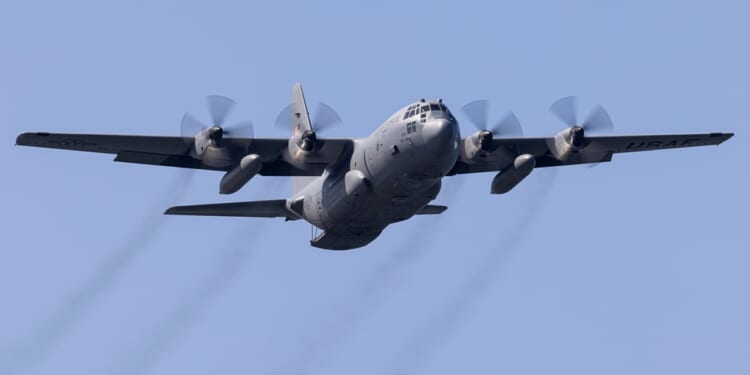Around the world, in hazardous and trying conditions, the C-130 has continuously proven itself.
The Lockheed C-130 Hercules has been the US Air Force’s tactical workhorse for seven decades. Never designed to be glamorous, the C-130 was instead built to last—and to haul, drop, lift, and land where more delicate aircraft could not. And through time, through decades of success, the C-130 has become a symbol of endurance, adaptability, and grit.
The C-130 Hercules’ Specifications
- Year Introduced: 1956
- Number Built: 2,600+ (across all variants; still in production as C-130J Super Hercules)
- Length: 97.8 ft (29.8 m) — C-130J-30 stretched variant: 112.9 ft (34.4 m)
- Wingspan: 132.6 ft (40.4 m)
- Weight: ~155,000 lb (70,300 kg) Maximum Takeoff Weight (varies by model)
- Engines: Four Rolls-Royce AE 2100D3 turboprops (~4,637 shp each on the C-130J)
- Top Speed: ~355 knots (410 mph, 660 km/h) at altitude
- Range: ~2,360 nmi (2,715 mi, 4,370 km) with max fuel and payload; ferry range up to ~4,000 nmi (4,600 mi, 7,400 km)
- Service Ceiling: ~33,000 ft (10,000 m)
- Loadout: Up to 42,000 lb (19,000 kg) cargo, 92 passengers, or 64 paratroopers; can carry vehicles, artillery, pallets, or be configured for aerial refueling, gunship (AC-130), or firefighting missions
- Aircrew: Typically 5 (pilot, co-pilot, navigator, flight engineer, and loadmaster) — reduced to 3 on modern C-130J models (2 pilots + 1 loadmaster)
The C-130 Was Built to Last
The C-130 was built with longevity in mind. The airframe was over-engineered to be tough. The skin is thick. The frame is stress tolerant. Four robust turboprop engines deliver thrust and control regardless of conditions, even in dirt, dust, or ice. And unlike sleek jet transports that require two miles of smooth concrete runways, the C-130 can operate from a 3,000 foot dirt strip. With high-mounted wings, tall landing gear, and a rear loading ramp, the rugged aircraft can take a beating.
But even well designed aircraft don’t typically endure for seven decades. The C-130 has beaten the odds, enduring because of its modularity and consistent upgrades. Over the years, the basic airframe has remained—but more than seventy distinct variants have been flown, serving a dizzying variety of purposes: gunship, search-and-rescue, weather recon, electronic-warfare, firefighting. Different versions of the C-130 have had their fuselage stretched or the wings refitted or the avionics modernized. Yet the original blueprint always remains the same because designers aced the original build.
Pilots compliment the C-130 the way soldiers complement the Jeep—a pilot can beat the thing up and pour abuse onto it, and it still performs well. The C-130 can lose an engine, even two, and still land safely. It can absorb small arms fire. Or fly in atmospheric conditions ranging from monsoon humidity to Arctic cold without issue.
Around the world, in hazardous and trying conditions, the C-130 has continuously proven itself. From the jungles of Vietnam to the deserts of Iraq to the mountain steps of Afghanistan, generations of airmen have learned to trust the C-130 for its steadiness and reliability. Even as the Air Force moves towards stealth and automation and ultra high-tech platforms, the hard-nosed C-130 remains a fixture.
The C-130 Plays a Valuable Strategic Role for America
But the C-130’s rugged durability is not merely a feat of engineering: its a consequential capability with significant strategic implications for the way the US military fights wars. Unlike high-performance jets that are confined to major bases, the C-130 gives commanders tactical reach—namely the ability to deliver men and materials directly into the fight without reliance on existing infrastructure. That translates into a global presence. Thanks to the C-130, the US military can project force just about anywhere within a few hours. And while the wisdom of projecting force just about anywhere within a few hours is debatable, the capability remains impressive. The workhorse C-130 is a cornerstone of modern air mobility doctrine, a single platform that facilitates both hard power and soft power.
Eventually, the C-130 will be phased out, likely in favor of something stealth and automated. But for now, in the still-manned Air Force, the C-130 is a staple as it has been for seventy years.
About the Author: Harrison Kass
Harrison Kass is a senior defense and national security writer at The National Interest. Kass is an attorney and former political candidate who joined the US Air Force as a pilot trainee before being medically discharged. He focuses on military strategy, aerospace, and global security affairs. He holds a JD from the University of Oregon and a master’s in Global Journalism and International Relations from NYU.
Image: Shutterstock / BlueBarronPhoto.

















